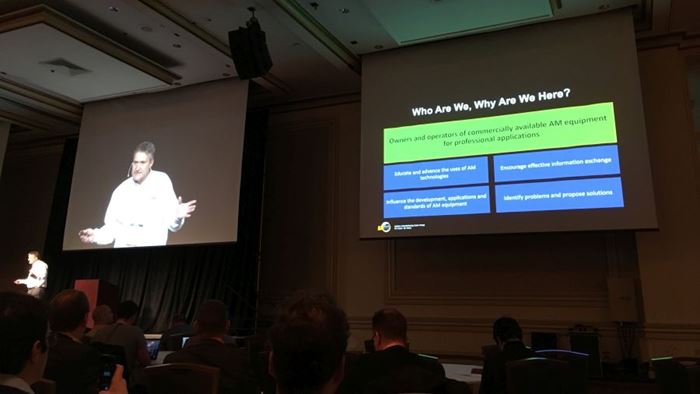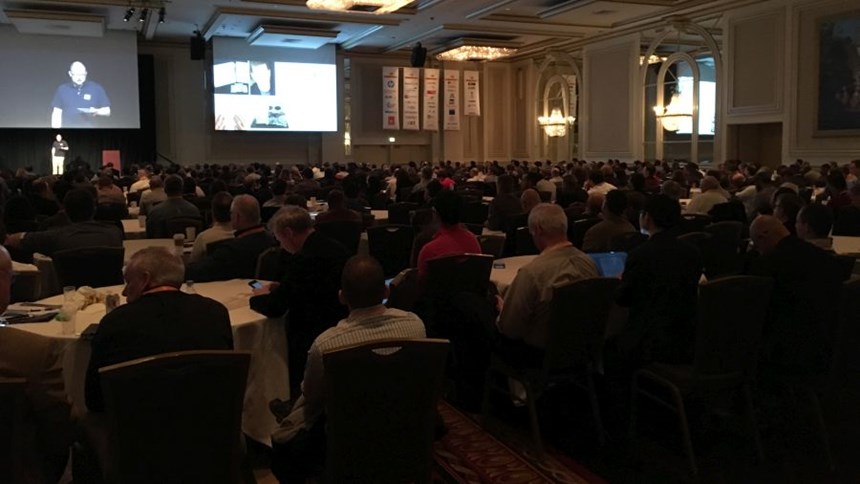Observations of AMUG 2017
Record attendance for the event this year threatened to exceed the capacity of the venue. Here are a few impressions of this year’s AMUG conference.
Share
This year’s Additive Manufacturing Users Group (AMUG) Conference drew the largest attendance yet for this annual event. Even though the facility was large—it was held this year in the Hilton Chicago, which has the largest total meeting and event space of any Chicago hotel—registration was halted at 1,600 attendees in the days before the event opened due to the capacity constraints of the seemingly abundant space that had been allotted. Since all the attendees of this distinctive event are users of an industrial 3D printer (formally, a requirement for registering to attend), the size of this turnout directly speaks to the extent of additive manufacturing’s continuing advance.
Here are some observations of the event this year:
1. Big and Small
AMUG President Steve Deak said the full attendance at this year’s conference, including exhibitor personnel and speakers, was 1,743. The vast majority of attendees therefore consisted of the organizers’ hoped-for audience of users of 3D printing in industrial applications. Clearly, there are now a lot of people in a lot of facilities making additive builds as part of their work.
And yet, there are still not enough to indicate that a transformation has arrived, or to drive that transformation with the weight of their own numbers. I heard this in some of the recurring themes—themes still recurring out of previous years. In discussions of the challenges facing additive manufacturing, one routinely cited was ignorance of the application and promise of AM among the customers and bosses of attendees to the event. In other words, the same concern that would have been expressed at this event in years prior. For as big as AM has become, it is still small within the culture and practice of manufacturing as a whole.
2. New Metal Machines Coming
Various companies with novel technologies for 3D printing metal parts, potentially at lower cost than established metal AM machines, were visible at the event. Some examples: XJet 3D prints in metal—and ceramic—using jetted droplets as the delivery mechanism for fine powder. The company will release its machine for sale this year. 3DEO, meanwhile, makes low-cost 3D-printed metal parts using a simplified variation on binder jetting. Entire layers are fused together in the company’s hybrid process, which employs a CNC cutter to generate the geometry of bonded layers. The company is making some parts today as a toolingless complement to metal injection molding, and it plans to significantly expand its number of machines yet this year. Also at the event, Desktop Metal seemed to be in force, or at least they were frequently near me, because I kept spotting their company shirts. Though details are few, this is a company also promising to release a low-cost metal 3D printer this year.
3. Production Is Now the Point
The movement of 3D printing away from making short runs or prototypes and into ongoing repetitive production is what the leading sponsors of the event generally wanted to talk about. For example: 3D Systems highlighted a platform for rationalizing and optimizing the total cost of ownership of 3D printing for production; Carbon showed a more powerful version of its printer developed for production, along with a complementary module for secondary processing; and Renishaw exhibited its metal AM equipment with its own QuantAM software and digital metrology technology (the type of technology on which the company was built) to emphasize that AM has process needs not just during 3D printing, but also before and after. Meanwhile, GE (see below) certainly wanted to emphasize production as well.
During my first day at the conference this year, I was visiting some exhibitors’ stands, and I began taking photos of 3D-printed parts they had on display. That is how one documents an additive manufacturing conference—sharing photos such as these is part of how we have traditionally covered such events. But no. The exercise seemed not quite right this year; it seemed out-of-step. This year, the focus of concern has moved beyond the mere 3D printing. At the AMUG event in particular, the attendees certainly already know well that 3D printing can generate elaborate and complex parts. But the next step is to do this at scale, and with consistency, addressing all of the needs that can allow this mode of making parts to assume its place as an accepted and established mode of production.
4. Eyes on GE
As the company that arguably has carried production AM the farthest, as well as championed it the most vocally, GE has long been a welcome presence at the AMUG event. GE personnel have come to the event as users and as speakers, and this year the company was there as a leading sponsor as well. 2017 marked the first AMUG conference since GE’s acquisitions of powder-bed metal AM technology makers Arcam and Concept Laser. Mohammad Ehteshami, head of the newly created GE Additive group, spoke of the company’s plans for these acquisitions and GE’s new role as technology provider to this market within a presentation to a standing-room-only crowd.
His main message: “We are selling machines!” The purpose of purchasing the companies was not to capture all of their output for GE’s own use, even though GE’s aims for AM in its own production will require it to install something like 1,000 more metal additive machines in the years to come. However, even this demand will capture only about 5 percent of the anticipated production of these machines by the acquired companies. For the rest of the output, GE hopes to expand the machines’ capabilities for other potential users by integrating them with GE technologies such as its Predix software platform for the industrial internet and data-driven manufacturing.
The attention to GE at this event was another element that brought out the feel of a tension between big and small, an awkward coming of age hinting at adolescence. AM is so big—so great in its promise and so important in its potential impact—that a company at the level of GE is giving it significant attention and resources just for the opportunity to shape its advance. But at the same time, the community of people and companies truly realizing AM is still small enough that the perturbations of just one company can transfix that community as a whole. Indeed, GE had a specimen of the LEAP fuel nozzle at the event (the company’s famous example of a metal component brought fully into production via AM), and—though I did not personally witness this—I was told that some attendees were taking selfies with this celebrity part.
As for how big this still-somewhat-small community might be when it fully comes of age, Mr. Ehteshami had a number: $76 billion. That is the potential size of the market for industrial production through additive manufacturing, he says. Where did he get that number? It can be defended a couple of different ways. The number represents the equivalent of just 0.5 percent of manufacturing going to additive, he says—if anything, a conservative estimate—or, alternately, it represents an amount of manufacturing activity around 50 percent of what the market for castings is today.
Read Next
Alquist 3D Looks Toward a Carbon-Sequestering Future with 3D Printed Infrastructure
The Colorado startup aims to reduce the carbon footprint of new buildings, homes and city infrastructure with robotic 3D printing and a specialized geopolymer material.
Read MoreProfilometry-Based Indentation Plastometry (PIP) as an Alternative to Standard Tensile Testing
UK-based Plastometrex offers a benchtop testing device utilizing PIP to quickly and easily analyze the yield strength, tensile strength and uniform elongation of samples and even printed parts. The solution is particularly useful for additive manufacturing.
Read MoreCrushable Lattices: The Lightweight Structures That Will Protect an Interplanetary Payload
NASA uses laser powder bed fusion plus chemical etching to create the lattice forms engineered to keep Mars rocks safe during a crash landing on Earth.
Read More



















